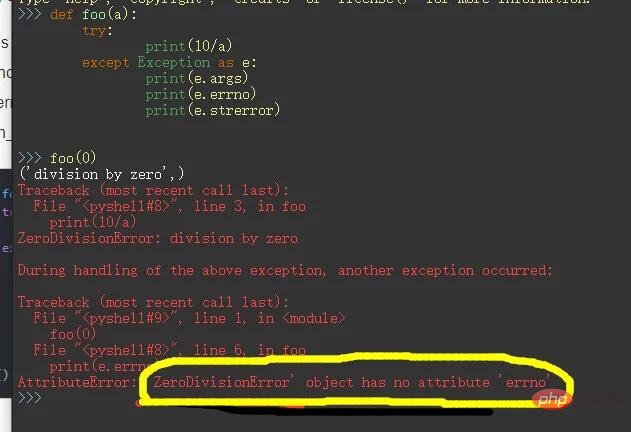Python의 예외 처리 예제 분석
- WBOYWBOYWBOYWBOYWBOYWBOYWBOYWBOYWBOYWBOYWBOYWBOYWB앞으로
- 2023-05-16 14:28:061642검색
1. 예외란 무엇입니까
파이썬에서 오류로 인해 발생하는 예외는 다음과 같습니다.

2. 예외의 유형
파이썬의 다양한 예외는 다양한 유형, 즉 예외 식별로 식별할 수 있습니다. 실수.
1. 일반적인 예외 클래스
-
AttributeError foo.x와 같은 객체가 없는 트리에 액세스하려고 하지만 foo에 속성이 없습니다.
ImportError 모듈이나 패키지를 가져올 수 없거나 기본적으로 경로 문제가 있습니다. name - IndentationError 구문 오류(하위 클래스); 코드가 제대로 정렬되지 않았습니다.
- IndexError x에 세 개의 요소만 있지만 액세스를 시도한 경우와 같이 첨자 인덱스가 시퀀스 경계를 초과합니다.
- SyntaxError Python 코드는 불법이며 코드를 컴파일할 수 없습니다. (개인적으로 구문 오류 및 오타라고 생각합니다.)
- TypeError 들어오는 개체 유형이 요구 사항을 충족하지 않습니다.
- UnboundLocalError 아직 설정되지 않은 로컬에 액세스하려고 합니다. 변수, 기본적으로 동일한 이름을 가진 다른 전역 변수가 있기 때문에 해당 변수에 액세스하고 있다고 생각하게 됩니다.
- ValueError는 값 유형이 올바른데도 호출자가 예상하지 못한 값을 전달합니다.
- 2 . 예외 예 :
# TypeError:int类型不可迭代 for i in 3: pass # ValueError num=input(">>: ") #输入hello int(num) # NameError aaa # IndexError l=['egon','aa'] l[3] # KeyError dic={'name':'egon'} dic['age'] # AttributeError class Foo:pass Foo.x # ZeroDivisionError:无法完成计算 res1=1/0 res2=1+'str'3. 예외 처리 - 1. 기본 구문 try... Except
try: 被检测的代码块 except 异常类型: try中一旦检测到异常,就执行这个位置的逻辑예
try:
f = [ 'a', 'a', 'a','a','a', 'a','a',]
g = (line.strip() for line in f) #元组推导式
print(next(g))
print(next(g))
print(next(g))
print(next(g))
print(next(g))
except StopIteration:
f.close()s1 = 'hello'
try:
int(s1)
except IndexError as e: # 未捕获到异常,程序直接报错
print(e)2. 다중 분기 제외..제외 및 보편적 예외: Exceptions1 = 'hello'
try:
int(s1)
except IndexError as e:
print(e)
except KeyError as e:
print(e)
except ValueError as e:
print(e)
except Exception as e:
print(e)for arg in sys.argv[1:]:
try:
f = open(arg, 'r')
except IOError:
print('cannot open', arg)
else:
print(arg, 'has', len(f.readlines()), 'lines')
f.close()4. 예외의 최종 실행 finallys1 = 'hello'
try:
int(s1)
except IndexError as e:
print(e)
except KeyError as e:
print(e)
except ValueError as e:
print(e)
#except Exception as e:
# print(e)
else:
print('try内代码块没有异常则执行我')
finally:
print('无论异常与否,都会执行该模块,通常是进行清理工作')
#기본 10인 int()에 대한 잘못된 리터럴: 'hello'# 예외 여부에 관계없이 이 모듈은 일반적으로 청소를 위해 실행됩니다. 4. 예외 던지기 raisePython은 raise 문을 사용하여 지정된 예외를 발생시킵니다. raise의 구문 형식은 다음과 같습니다.
raise [Exception [, args [, traceback]]]
try:
raise TypeError('抛出异常,类型错误')
except Exception as e:
print(e)
raise 유일한 매개 변수는 throw될 예외를 지정합니다. 예외 인스턴스이거나 예외 클래스(즉, Exception의 하위 클래스)여야 합니다. 이 예외가 발생했는지 알고 싶고 이를 처리하고 싶지 않은 경우 간단한 raise 문으로 예외를 다시 발생시킬 수 있습니다. try:
raise NameError('HiThere')
except NameError:
print('An exception flew by!')
raise
#An exception flew by!
#Traceback (most recent call last):
# File "", line 2, in ?
#NameError: HiThere 5. 사용자 정의 예외 새로운 예외 클래스를 생성하여 자신만의 예외를 가질 수 있습니다. 예외 클래스는 Exception 클래스에서 직접 또는 간접적으로 상속합니다. 예를 들면 다음과 같습니다. 이 예에서는 Exception 클래스의 기본 __init__()가 재정의됩니다. class EgonException(Exception):
def __init__(self, msg):
self.msg = msg
def __str__(self):
return self.msg
try:
raise EgonException('抛出异常,类型错误')
except EgonException as e:
print(e)
#抛出异常,类型错误기본 예외 클래스다양한 예외가 발생할 수 있는 모듈을 생성할 때 일반적인 접근 방식은 이 패키지에 대한 기본 예외 클래스를 생성한 다음 이 기본 클래스를 기반으로 다양한 오류 상황에 대한 다양한 예외를 생성하는 것입니다. :대부분의 예외 이름은 표준 예외 이름 지정과 마찬가지로 "Error"로 끝납니다. class Error(Exception):
"""Base class for exceptions in this module."""
pass
class InputError(Error):
"""Exception raised for errors in the input.
Attributes:
expression -- input expression in which the error occurred
message -- explanation of the error
"""
def __init__(self, expression, message):
self.expression = expression
self.message = message
class TransitionError(Error):
"""Raised when an operation attempts a state transition that's not
allowed.
Attributes:
previous -- state at beginning of transition
next -- attempted new state
message -- explanation of why the specific transition is not allowed
"""
def __init__(self, previous, next, message):
self.previous = previous
self.next = next
self.message = message
6. Assert assert(assert)는 표현식을 판단하고 표현식 조건이 false일 때 예외를 발생시키는 데 사용됩니다. 어설션은 프로그램 실행 후 프로그램이 충돌할 때까지 기다릴 필요 없이 프로그램 실행 조건이 충족되지 않을 때 직접 오류를 반환할 수 있습니다. 구문 형식은 다음과 같습니다. assert expression는
if not expression:
raise AssertionError
assert와 동일합니다. 매개변수도 뒤에 올 수 있습니다. assert expression [, arguments]는
if not expression:
raise AssertionError(arguments)와 동일합니다. 다음 예에서는 현재 시스템이 Linux인지 확인합니다. 조건이 충족되지 않으면 직접 트리거됩니다. 예외이므로 다음 코드를 실행할 필요가 없습니다. import sys
assert ('linux' in sys.platform), "该代码只能在 Linux 下执行"
# 接下来要执行的代码
# Traceback (most recent call last):
# File "C:/PycharmProjects/untitled/run.py", line 2, in
# assert ('linux' in sys.platform), "该代码只能在 Linux 下执行"
# AssertionError: 该代码只能在 Linux 下执行
위 내용은 Python의 예외 처리 예제 분석의 상세 내용입니다. 자세한 내용은 PHP 중국어 웹사이트의 기타 관련 기사를 참조하세요!
성명:
이 기사는 yisu.com에서 복제됩니다. 침해가 있는 경우 admin@php.cn으로 문의하시기 바랍니다. 삭제

